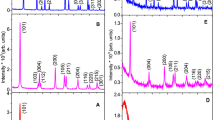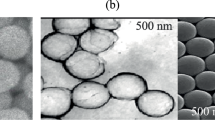Abstract
The effects of temperature and interfacial elasticity on nanostructured titanium dioxide (TiO2) microemulsions templated materials have been investigated. The aim was to establish a simple and rapid selection of the best experimental conditions for achieving some required material property. TiO2 materials have been prepared through reactive microemulsion precipitation. The effect of microemulsion process parameters (temperature and oil phase density) on the final material characteristics has been investigated. The titania nanopowders were characterized by X-ray diffraction, Fourier transform infrared spectroscopy, field emission scanning electron microscopy, and N2 adsorption–desorption isotherms. The results obtained by different process conditions show that the nonpolar phase density and temperature of microemulsions have a great influence on the final characteristics of the obtained material. A reduction of the microemulsion oil density causes a significant decrease in the particle agglomeration and an augment of the material-specific surface area and pore volume. At the same time, rutile is favored over anatase phase. The increase of template microemulsion temperature produces, in some systems, a morphology change from granular to a bicontinuous structure.







Similar content being viewed by others
References
Gratzel M (2001) Photoelectrochemical cells. Nature 414(6861):338–344
Burda C, Chen X, Narayanan R, El-Sayed MA (2005) Chemistry and properties of nanocrystals of different shapes. Chem Rev 105(4):1025–1102. doi:10.1021/cr030063a
Cozzoli PD, Pellegrino T, Manna L (2006) Synthesis, properties and perspectives of hybrid nanocrystal structures. Chem Soc Rev 35(11):1195–1208
Stone V, Nowack B, Baun A, van den Brink N, von der Kammer F, Dusinska M, Handy R, Hankin S, Hassellöv M, Joner E, Fernandes TF (2010) Nanomaterials for environmental studies: classification, reference material issues, and strategies for physico-chemical characterisation. Sci Total Environ 408(7):1745–1754. doi:10.1016/j.scitotenv.2009.10.035
Kim DS, Han SJ, Kwak S-Y (2007) Synthesis and photocatalytic activity of mesoporous TiO2 with the surface area, crystallite size, and pore size. J Colloid Interface Sci 316(1):85–91. doi:10.1016/j.jcis.2007.07.037
Zallen R, Moret MP (2006) The optical absorption edge of brookite TiO2. Solid State Commun 137(3):154–157. doi:10.1016/j.ssc.2005.10.024
Lan Y, Gao XP, Zhu HY, Zheng ZF, Yan TY, Wu F, Ringer SP, Song DY (2005) Titanate nanotubes and nanorods prepared from rutile powder. Adv Funct Mater 15(8):1310–1318. doi:10.1002/adfm.200400353
Holland BT, Blanford CF, Stein A (1998) Synthesis of macroporous minerals with highly ordered three-dimensional arrays of spheroidal voids. Science 281(5376):538–540. doi:10.1126/science.281.5376.538
Meilert KT, Laub D, Kiwi J (2005) Photocatalytic self-cleaning of modified cotton textiles by TiO2 clusters attached by chemical spacers. J Mol Catal A Chem 237(1–2):101–108. doi:10.1016/j.molcata.2005.03.040
Mor GK, Oomman KV, Maggie P, Craig AG (2003) A self-cleaning, room-temperature titania-nanotube hydrogen gas sensor. Sens Lett 1(1):42–46. doi:10.1166/sl.2003.013
Liu D, Zhang J, Han B, Chen J, Li Z, Shen D, Yang G (2003) Recovery of TiO2 nanoparticles synthesized in reverse micelles by antisolvent CO2. Colloids Surf, A Physicochem Eng Asp 227(1–3):45–48. doi:10.1016/s0927-7757(03)00385-6
The President's Council of Advisors on Science and Technology (2010). Report to the President and Congress on the third assessment of The National Nanotechnology Initiative. Executive Office of the President, White House Office of Science and Technology Policy. Washington, D.C.
Shapira P, Wang J (2010) Follow the money. Nature 468(7324):627–628
Cargnello M, Wieder NL, Montini T, Gorte RJ, Fornasiero P (2010) Synthesis of dispersible Pd@CeO2 core-shell nanostructures by self-assembly. J Am Chem Soc 132(4):1402–1409. doi:10.1021/ja909131k
Liu Z, Zhang X, Poyraz S, Surwade SP, Manohar SK (2010) Oxidative template for conducting polymer nanoclips. J Am Chem Soc 132(38):13158–13159. doi:10.1021/ja105966c
Fernández-Leyes M, Verdinelli V, Hassan N, Ruso J, Pieroni O, Schulz P, Messina P (2012) Biomimetic formation of crystalline bone-like apatite layers on spongy materials templated by bile salts aggregates. J Mater Sci 47(6):2837–2844. doi:10.1007/s10853-011-6113-4
Yoder NC, Kalsani V, Schuy S, Vogel R, Janshoff A, Kumar K (2007) Nanoscale patterning in mixed fluorocarbon/hydrocarbon phospholipid bilayers. J Am Chem Soc 129(29):9037–9043. doi:10.1021/ja070950l
Mosquera V, Ruso JM, Prieto G, Sarmiento F (1996) Characterization of the interactions between lysozyme and n-alkyltrimethylammonium bromides by zeta potential measurements. J Phys Chem 100(41):16749–16753. doi:10.1021/jp960927e
Sabín J, Prieto G, Messina PV, Ruso JM, Hidalgo-Alvarez R, Sarmiento F (2005) On the effect of Ca2+ and La3+ on the colloidal stability of liposomes. Langmuir 21(24):10968–10975. doi:10.1021/la051397t
Ruso JM, Taboada P, Martínez-Landeira P, Prieto G, Sarmiento F (2001) A comparative study of the interaction between nafcillin and catalase by equilibrium dialysis and ζ-potential measurements. J Phys Chem B 105(13):2644–2648. doi:10.1021/jp003404m
Lu C-H, Wu W-H, Kale RB (2008) Microemulsion-mediated hydrothermal synthesis of photocatalytic TiO2 powders. J Hazard Mater 154(1–3):649–654. doi:10.1016/j.jhazmat.2007.10.074
Deorsola FA, Vallauri D (2009) Study of the process parameters in the synthesis of TiO2 nanospheres through reactive microemulsion precipitation. Powder Technol 190(3):304–309. doi:10.1016/j.powtec.2008.08.009
Hassan N, Verdinelli V, Ruso JM, Messina PV (2011) Mimicking natural fibrous structures of opals by means of a microemulsion-mediated hydrothermal method. Langmuir 27(14):8905–8912. doi:10.1021/la201555f
Hassan N, Verdinelli V, Ruso JM, Messina PV (2012) Assessing structure and dynamics of fibrinogen films on silicon nanofibers: towards hemocompatibility devices. Soft Matter 8(24):2582–2592
Hellweg T (2002) Phase structures of microemulsions. Curr Opin Colloid Interface Sci 7(1–2):50–56. doi:10.1016/s1359-0294(02)00004-3
Pileni MP (1997) Nanosized particles made in colloidal assemblies. Langmuir 13(13):3266–3276. doi:10.1021/la960319q
Pileni MP (2001) Mesostructured fluids in oil-rich regions: structural and templating approaches. Langmuir 17(24):7476–7486. doi:10.1021/la010538y
Shevachman M, Shani A, Garti N (2004) Formation and investigation of microemulsions based on jojoba oil and nonionic surfactants. J Am Oil Chem Soc 81(12):1143–1152. doi:10.1007/s11746-004-1032-2
Schlicht L, Spilgies JH, Runge F, Lipgens S, Boye S, Schübel D, Ilgenfritz G (1996) Temperature-, electric field- and solute-induced percolation in water-in-oil microemulsions. Biophys Chem 58(1–2):39–52. doi:10.1016/0301-4622(95)00084-4
Van Dijk MA, Joosten JGH, Levine YK, Bedeaux D (1989) Dielectric study of temperature-dependent aerosol OT/water/isooctane microemulsion structure. J Phys Chem 93(6):2506–2512. doi:10.1021/j100343a054
Moha-Ouchane M, Peyrelasse J, Boned C (1987) Percolation transition in microemulsions: effect of water-surfactant ratio, temperature, and salinity. Phys RevA 35(7):3027–3032
Alexandridis P, Holzwarth JF, Hatton TA (1993) Interfacial dynamics of water-in-oil microemulsion droplets: determination of the bending modulus using iodine laser temperature jump. Langmuir 9(8):2045–2052. doi:10.1021/la00032a024
Alexandridis P, Holzwarth JF, Hatton TA (1995) Thermodynamics of droplet clustering in percolating AOT water-in-oil microemulsions. J Phys Chem 99(20):8222–8232. doi:10.1021/j100020a054
Giorgilli A, Casati D, Sironi L, Galgani L (1986) An efficient procedure to compute fractal dimensions by box counting. Phys Lett A 115(5):202–206. doi:10.1016/0375-9601(86)90465-2
Foroutan-pour K, Dutilleul P, Smith DL (1999) Advances in the implementation of the box-counting method of fractal dimension estimation. Appl Math Comput 105(2–3):195–210. doi:10.1016/s0096-3003(98)10096-6
Bau S, Witschger O, Gensdarmes F, Rastoix O, Thomas D (2010) A TEM-based method as an alternative to the BET method for measuring off-line the specific surface area of nanoaerosols. Powder Technol 200(3):190–201. doi:10.1016/j.powtec.2010.02.023
Ibaseta N, Biscans B (2010) Fractal dimension of fumed silica: comparison of light scattering and electron microscope methods. Powder Technol 203(2):206–210. doi:10.1016/j.powtec.2010.05.010
Chang C-L, Fogler HS (1997) Controlled formation of silica particles from tetraethyl orthosilicate in nonionic water-in-oil microemulsions. Langmuir 13(13):3295–3307. doi:10.1021/la961062z
Mohapatra P, Mishra T, Parida KM (2006) Effect of microemulsion composition on textural and photocatalytic activity of titania nanomaterial. Appl Catal Gen 310:183–189. doi:10.1016/j.apcata.2006.05.041
Spurr RA, Myers H (1957) Quantitative analysis of anatase-rutile mixtures with an X-ray diffractometer. Anal Chem 29(5):760–762. doi:10.1021/ac60125a006
Periyat P, McCormack DE, Hinder SJ, Pillai SC (2009) One-pot synthesis of anionic (nitrogen) and cationic (sulfur) codoped high-temperature stable, visible light active, anatase photocatalysts. J Phys Chem C 113(8):3246–3253. doi:10.1021/jp808444y
Naono H, Hakuman M, Shiono T (1997) Analysis of nitrogen adsorption isotherms for a series of porous silicas with uniform and cylindrical pores: a new method of calculating pore size distribution of pore radius 1–2 nm. J Colloid Interface Sci 186(2):360–368. doi:10.1006/jcis.1996.4677
Lippens BC, Linsen BG, Boer JH (1964) Studies on pore systems in catalysts I. The adsorption of nitrogen; apparatus and calculation. J Catal 3(1):32–37. doi:10.1016/0021-9517(64)90089-2
Barrett EP, Joyner LG, Halenda PP (1951) The determination of pore volume and area distributions in porous substances. I. Computations from nitrogen isotherms. J Am Chem Soc 73(1):373–380. doi:10.1021/ja01145a126
de Boer JH, Lippens BC, Linsen BG, Broekhoff JCP, van den Heuvel A, Osinga TJ (1966) Thet-curve of multimolecular N2-adsorption. J Colloid Interface Sci 21(4):405–414. doi:10.1016/0095-8522(66)90006-7
Halsey G (1948) Physical adsorption on non-uniform surfaces. J Chem Phys 16(10):931–937
Limin Q (2007) Synthesis of inorganic nanostructures in reverse micelles. In: Encyclopedia of surface and colloid Science, 2nd edn. Taylor & Francis, New York, pp 6183–6207. doi:10.1081/E-ESCS-120023694
Yadav OP, Palmqvist A, Cruise N, Holmberg K (2003) Synthesis of platinum nanoparticles in microemulsions and their catalytic activity for the oxidation of carbon monoxide. Colloids Surf, A Physicochem Eng Asp 221(1–3):131–134. doi:10.1016/s0927-7757(03)00141-9
Nicholson JD, Clarke LH (1984) In: Mittal KL, Lindman B (eds) Surfactants in solution. New York, Plenum
Hamilton RT, Billman JF, Kaler EW (1990) Measurements of interdroplet attractions and the onset of percolation in water-in-oil microemulsions. Langmuir 6(11):1696–1700. doi:10.1021/la00101a013
Johannsson R, Almgren M, Alsins J (1991) Fluorescence and phosphorescence study of AOT/water/alkane systems in the L2 reversed micellar phase. J Phys Chem 95(9):3819–3823. doi:10.1021/j100162a070
Moriguchi I, Hidaka R, Yamada H, Kudo T (2005) Li-intercalation property of mesoporous anatase-TiO2 synthesized by bicontinuous microemulsion-aided process. Solid State Ionics 176(31–34):2361–2366. doi:10.1016/j.ssi.2005.02.029
Zhao X, Yu J, Cheng B, Zhang Q (2005) Crystallization of lead sulfide in the presence of poly(methacrylic acid) or/and cetyltrimethylammonium bromide. Colloids Surf, A Physicochem Eng Asp 268(1–3):78–84. doi:10.1016/j.colsurfa.2005.05.063
Bujan M, Sikirić M, Filipović-Vinceković N, Vdović N, Garti N, Füredi-Milhofer H (2001) Effect of anionic surfactants on crystal growth of calcium hydrogen phosphate dihydrate. Langmuir 17(21):6461–6470. doi:10.1021/la0107190
Mercera PDL, Van Ommen JG, Doesburg EBM, Burggraaf AJ, Ross JRH (1992) Influence of ethanol washing of the hydrous precursor on the textural and structural properties of zirconia. J Mater Sci 27(18):4890–4898. doi:10.1007/bf01105251
Ha PS, Youn H-J, Jung HS, Hong KS, Park YH, Ko KH (2000) Anatase–rutile transition of precipitated titanium oxide with alcohol rinsing. J Colloid Interface Sci 223(1):16–20. doi:10.1006/jcis.1999.6607
Eicke HF, Borkovec M, Das-Gupta B (1989) Conductivity of water-in-oil microemulsions: a quantitative charge fluctuation model. J Phys Chem 93(1):314–317. doi:10.1021/j100338a062
Acknowledgments
The authors acknowledge the Xunta de Galicia (project no. 10PXIB206258PR) and Universidad Nacional del Sur, Concejo Nacional de Investigaciones Científicas y Técnicas de la República Argentina (CONICET, PIP-11220100100072).
Author information
Authors and Affiliations
Corresponding author
Rights and permissions
About this article
Cite this article
Messina, P.V., Verdinelli, V., Pieroni, O. et al. Role of interfacial elasticity of microemulsions on the morphology of TiO2 nanostructures: stiff templates versus flexible templates. Colloid Polym Sci 291, 835–844 (2013). https://doi.org/10.1007/s00396-012-2798-4
Received:
Revised:
Accepted:
Published:
Issue Date:
DOI: https://doi.org/10.1007/s00396-012-2798-4




